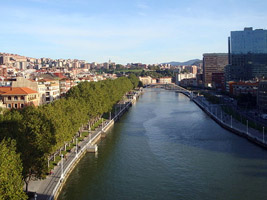 |
Spain | Travel | Regions | Cities | Coasts | Islands | Culture |
| Spain / Basque Country / Basque Coast / Bilbao |
|
| More Information | ||
| Destinations | ||
| Plan your Trip | ||
| ||||||
 Bilbao is the largest city in the Basque Country and also the most important industrial and commercial center.
Bilbao is the largest city in the Basque Country and also the most important industrial and commercial center.The city is located at the mouth of the Ria de Bilbao Major AttractionsThe modern landmark of Bilbao is without doubt the Guggenheim Museum, which has been completed in 1997. We shall dedicate a special page to it.In the very heart of thown there is the Mercado de la Ribera The Old Town The lively Plaza Nueva ("new square", in basque Plaza Berria) dates from the 19th century. Under its arcades, there are many shops and restaurants. Every Sunday a flea market takes place here, and in summer there are often evening concerts and folklore performances. Interesting is also the Plaza Eliptica ("elliptic square", in basque Plaza Moyua), with its Palacio de Chávarri Another beautiful palace from 19th century is the Palacio de la Diputación Foral de Vizcaya in the street Gran Via Bilbaina. Also these following buildings are worth seeing: The town-hall of Bilbao The most important religious buildings in Bilbao are: the Gothic cathedral Catedral de Santiago And also apart from the Guggenheim-Museum there are more examples of outstanding modern architecture in Bilbao: The twin towers Torres Isozaki The bridge Zubizuri The subway Metro Bilbao with its no-frills, funcional design. The renowned architect Norman Foster designed some stations as well as two all-new subway lines, and he used almost exclusively the materials steel, concrete and glass. Close to Bilbao, in Portugalete, there is the Puente Colgante de Vizcaya MuseumsGuggenheim-Museum - probably the best known museum of Bilbao, and the largest crowd puller.The Museo de Bellas Artes ("Museum of Fine Arts") is among the most important of all Spain, among others there are works of El Greco, Bacon, Goya, Zurbaran, Murillo, Zuloaga, Sorolla, Cezanne, Gauguin, Van Dyck, Dali, Chillida and Tapies. The Maritime Museum Museo Marítimo Ría de Bilbao shows us the importance of the Basque shipyards. On exhibition are both ships and many models. The Basque Museum (Museo Vasco, in basque Euskal Museoa) deals specifically with the history of the Basque Country. Every Thursday the entrance is free. In the Museo de Reproducciones you find strikingly realistic copies of known masterpieces in their original format. Some more hintsPintxos (skewers): Pintxos are small snacks, comparable to the "tapas" which are known from other parts of Spain. Usually they are artfully presented at the bar, and customers serve themselves. Inside there are small skewers (hence the name), often of different lengths, which are then counted by the waiter when you ask for the bill.Also recommended is a ride on the Funicular de Artxanda on a hill where you may relax and enjoy the magnificent view. |